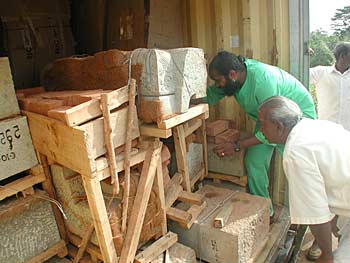Blog Archives
Gurudeva’s Statement — Attack on America


As we reflect on the many great gifts that Gurudeva gave us all, we are continually amazed. Above you see him working with Shanmuganathaswami on his email for the day. What other Gurus do you know who would take on the full spiritual responsibility not only for your personal karma, guidance in your family, marital life and most importantly, your spiritual transformation as a soul being? And who, to do that, gave you access as instantly as an email? On the right is Satguru Bodhinatha Veylanswami on the Guru Peetham. All the monks look up to Bodhinatha as the embodiment of Gurudeva. And, while we may still grieve at our personal loss, we are all strong and the Paramapara is as solid as a rock. Bodhinathaswami also now answers the daily email from the sishya of Saiva Siddhanta Church.
No Audio Today
Take this opportunity for an adventure.
Close your eyes and click to get a message
picked at random from Gurudeva’s vast audio archives
 |
|
|
 |
||

Gurudeva’s work has touched so many people the world over in some many subtle ways. Here is a text book just recently published which will be used in schools in America to teach about Buddhists, Hindus and Sikhs in America. They requested permission to use the painting of Iraivan Temple on the cover!
 The Remarkable Vision |
Iraivan Temple Progress Update |
Join this historic undertaking. Please contribute generously. Sponsor a stone today! |

Speaking of Iraivan, five containers have arrived in Hawaii and two of them were delivered to the temple site this morning. Yoginathaswami and Shanmuga Sthapati survey the loaded crates, and strategize unloading.

Each container carries about 20-30 stones

Sthapati and silpis plan the disembarkment of the stones very carefully, marking off on their drawings each stone by it’s number as it is unloaded. Careful placement now will mean that the next stones needed will be easily accessed without having to move other stones.

Sthapati (on the right) is also concerned to see that every stone he needs for the next few courses is in fact present in the shipment. Inside the container the local Kauai Agricultural Inspection team checks every piece of wood in the crating for possible boring, wood eating insects. The containers were fumigated in India and none have been found so far.

Another “red letter” day for the Iraivan Temple progress, Haro Hara! Vetri Vel Muruganukku!
Please give generously to the project, contact Iraivan@hindu.org for details on sponsorhip of a stone, making a monthly pledge, year-end tax-deductible large donations (US residents).

|
Study Gurudeva’s teachings.
|
transcription begins
Date: November_26_2001
Title: Appreciation
Category: Good Conduct
Duration: 8 min., 6 secs
Date Given: November 24, 2001
Given by: Bodhinatha
So I thought I would talk this morning, a little bit about ‘Appreciation’.
We have been getting some copies of e-mails coming from members abroad, going to the members of the Wailua Mission, verbalizing their appreciation for all the hospitality they received during their stay here for one or two weeks or more during our recent event. It is wonderful to see that because appreciation is something we often feel but don’t often enough express. Somehow, it is just not that common, not in our social norm, to spend a lot of time verbalizing our appreciation for what others have done for us. So quite often, other people really don’t know and feel the benefit of what we feel on the inside toward them. We haven’t told them. So they don’t get that. But it is important, a very important part of life.
I have a story to tell about a bird, this is a true story. We eat lunch in the court yard, seated on the ground and we used to serve right on top of the counter. So we have all the serving dishes there. One spring season there was a bird, I imagine the bird had young. The bird figured out when the food was out. The bird would come everyday at the same time, fly down, grab a little food, go away, come back a second time, grab a little food and fly away.
We began noticing this happening everyday. So we started putting out different little piles of food so it was easier, so the bird didn’t have to go into our serving dish. We put out a little pile of food on the counter and the bird would fly down, grab the food and go away. Then, we realized the bird liked tofu. So we made sure whenever we made tofu, we put tofu in the pile and the bird would come down, grab the tofu and fly away and then come back again, grab the food and fly away.
One day the bird did that and then came back a third time and sang the most beautiful song. It just went on and on with this beautiful song. It was like expressing appreciation. It didn’t have to come back and sing to us. There wasn’t any food, it didn’t want food. Just on its own accord, it came back and sat where it usually did, on top of the water faucet and sang this beautiful song of appreciation. At least, that is how it registered to me! So, whenever I think of appreciation I think of that bird.
It struck me that appreciation is such a beautiful expression of culture. It is also an important balance in life because life has its ups and downs. When we are up, we are fine but when we are down, we are not. When we are down, we can get discouraged, depressed, wonder how other people feel about us and go through moods and emotions. One of the factors which helps pull us out of that is, if we have been appreciated. If we feel others appreciate us, it is easier to pull ourselves out of those moods. But, if we don’t feel appreciated, if we kind of feel isolated, by ourselves, then it can be hard to pull out of such a state of mind.
Appreciation helps everyone keep up, keep buoyant and handle the difficulties in life a little easier. Appreciation also relates to the idea of training someone or correcting someone. We are all in situation where that manifests. The most common situation is the parents and children. Parents are responsible for training the children. In the workplace, we may be a supervisor. We may have certain responsibilities for others under us and then we are in the same situation of training others. Of course a teacher in a classroom is in a situation similar to a parent, there is obviously training going on. We are molding the minds of a younger generation. In the monastery we have structures, kulam structures whereby the head of the kulam is responsible for training the individuals in the kulam. Sometimes we even have subgroups in the kulam, where there is an individual who is the most experienced, responsible for training others. So this idea of appreciation carries over into all training situations – parent-child, teacher-student, supervisor-supervised, talaivar-member of the kulam, applies to a guru, applies to any teacher, a music teacher, a dance teacher.
We need to balance praise and blame. We have to balance praise and blame. What does that mean? It means we need to verbalize the good qualities, the successes, towards our children, praise them when things go well, tell them how wonderful they are, tell them we love them. We need to praise our students. As a supervisor, we need to praise those who are supervised, when they do things well and encourage them, show them we care. A talaivar praises members of the kulams when they do things well. Then, the majority of impressions that have gone into the mind are one of praise, one that everything is going well, one that we are loved. When there is a need to correct and that is verbalized, it is taken well because the majority of impressions that we have between the two parties is one of praise, one of love, one of kindness. So an impression of correction for doing something wrong isn’t a devastation, because that is not the majority of impressions.
But if we don’t hit the right balance, you can see what happens. The mind gets filled up with too much correction and then it doesn’t find the right balance. Correction goes in upon other correction and doesn’t produce the desired result. The behavior doesn’t change. It is just one more correction going in on to many corrections. So the idea of a correction isn’t to tell someone they are bad or wrong. The idea is to change behavior, right? We want to change someone’s behavior, if their behavior isn’t right for some reason, it can be improved upon. So in order to motivate the person through correction, it has to go into a mind that is filled with praise. Even if a dance teacher only gives corrections, eventually the student will give up, saying, “This is impossible. I can’t seem to do anything right.”
We have to find the right balance with enough praise so that the correction is taken in a way that the person is motivated to change behavior. Otherwise, the person just gets discouraged and doesn’t want to even try and change the behavior.
transcription ends
|
MORE UPLIFTING THINGS |
Innersearch postponed
Due to the horrific tragedies of September 11th, Himalayan Academy has indefinitely postponed the Canadian Innersearch scheduled to leave next July. Please be assured, we will re-schedule the Innersearch, but only when the present insecurity around the world settles down. Until then, if you are planning to go on a future Innersearch program, continue to set aside a little income each month in a special fund. |
|

|
Check our children and youth section for new items for the young and young at heart! | |
|
1. SIGN OUR GUESTBOOK and receive a FREE GIFT |
||
|
2. Newest Book: HOW TO BECOME A HINDU |
||
|
3. Visiting KAUAI’S HINDU MONASTERY |
||
|
to the THANK YOU, GURUDEVA FUND |
||
From Our Gurus' Teachings
Archives are now available through 2001. Light colored days have no posts. 1998-2001 coming later.
